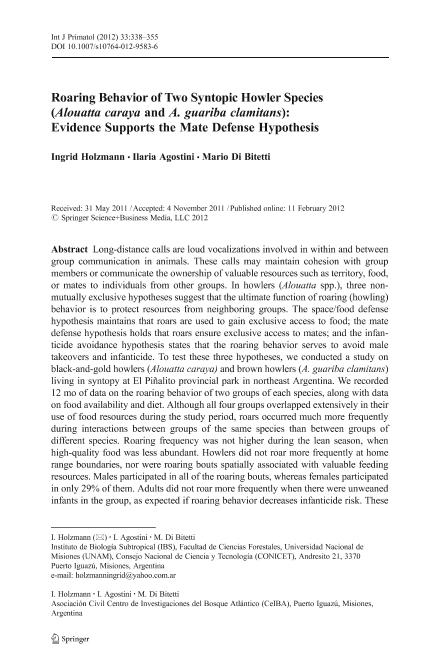Mostrar el registro sencillo del ítem
dc.contributor.author
Holzmann, Ingrid

dc.contributor.author
Agostini, Ilaria

dc.contributor.author
Di Bitetti, Mario Santiago

dc.date.available
2017-06-01T21:26:05Z
dc.date.issued
2012-04
dc.identifier.citation
Holzmann, Ingrid; Agostini, Ilaria; Di Bitetti, Mario Santiago; Roaring Behavior of Two Syntopic Howler Species (Alouatta caraya and A. guariba clamitans): Evidence Supports the Mate Defense Hypothesis; Springer; International Journal Of Primatology; 33; 2; 4-2012; 338-355
dc.identifier.issn
0164-0291
dc.identifier.uri
http://hdl.handle.net/11336/17348
dc.description.abstract
Long-distance calls are loud vocalizations involved in within and between group communication in animals. These calls may maintain cohesion with group members or communicate the ownership of valuable resources such as territory, food, or mates to individuals from other groups. In howlers (Alouatta spp.), three nonmutually exclusive hypotheses suggest that the ultimate function of roaring (howling) behavior is to protect resources from neighboring groups. The space/food defense hypothesis maintains that roars are used to gain exclusive access to food; the mate defense hypothesis holds that roars ensure exclusive access to mates; and the infanticide avoidance hypothesis states that the roaring behavior serves to avoid male takeovers and infanticide. To test these three hypotheses, we conducted a study on black-and-gold howlers (Alouatta caraya) and brown howlers (A. guariba clamitans) living in syntopy at El Piñalito provincial park in northeast Argentina. We recorded 12 mo of data on the roaring behavior of two groups of each species, along with data on food availability and diet. Although all four groups overlapped extensively in their use of food resources during the study period, roars occurred much more frequently during interactions between groups of the same species than between groups of different species. Roaring frequency was not higher during the lean season, when high-quality food was less abundant. Howlers did not roar more frequently at home range boundaries, nor were roaring bouts spatially associated with valuable feeding resources. Males participated in all of the roaring bouts, whereas females participated in only 29% of them. Adults did not roar more frequently when there were unweaned infants in the group, as expected if roaring behavior decreases infanticide risk. These results provide no support for the food defense or infanticide avoidance hypotheses, but support predictions derived from the mate defense hypothesis.
dc.format
application/pdf
dc.language.iso
eng
dc.publisher
Springer

dc.rights
info:eu-repo/semantics/openAccess
dc.rights.uri
https://creativecommons.org/licenses/by-nc-sa/2.5/ar/
dc.subject
Alouatta Caraya
dc.subject
Alouatta Guariba Clamitans
dc.subject
Female Defense
dc.subject
Food Defense
dc.subject
Infanticide
dc.subject
Long-Distance Calls
dc.subject.classification
Zoología, Ornitología, Entomología, Etología

dc.subject.classification
Ciencias Biológicas

dc.subject.classification
CIENCIAS NATURALES Y EXACTAS

dc.title
Roaring Behavior of Two Syntopic Howler Species (Alouatta caraya and A. guariba clamitans): Evidence Supports the Mate Defense Hypothesis
dc.type
info:eu-repo/semantics/article
dc.type
info:ar-repo/semantics/artículo
dc.type
info:eu-repo/semantics/publishedVersion
dc.date.updated
2017-02-06T14:24:48Z
dc.identifier.eissn
1573-8604
dc.journal.volume
33
dc.journal.number
2
dc.journal.pagination
338-355
dc.journal.pais
Estados Unidos

dc.journal.ciudad
Nueva York
dc.description.fil
Fil: Holzmann, Ingrid. Consejo Nacional de Investigaciones Científicas y Técnicas. Centro Científico Tecnológico Conicet - Nordeste. Instituto de Biología Subtropical. Universidad Nacional de Misiones. Instituto de Biología Subtropical; Argentina. Centro de Investigaciones del Bosque Atlantico; Argentina
dc.description.fil
Fil: Agostini, Ilaria. Consejo Nacional de Investigaciones Científicas y Técnicas. Centro Científico Tecnológico Conicet - Nordeste. Instituto de Biología Subtropical. Universidad Nacional de Misiones. Instituto de Biología Subtropical; Argentina. Centro de Investigaciones del Bosque Atlantico; Argentina
dc.description.fil
Fil: Di Bitetti, Mario Santiago. Consejo Nacional de Investigaciones Científicas y Técnicas. Centro Científico Tecnológico Conicet - Nordeste. Instituto de Biología Subtropical. Universidad Nacional de Misiones. Instituto de Biología Subtropical; Argentina. Centro de Investigaciones del Bosque Atlantico; Argentina
dc.journal.title
International Journal Of Primatology

dc.relation.alternativeid
info:eu-repo/semantics/altIdentifier/doi/http://dx.doi.org/10.1007/s10764-012-9583-6
dc.relation.alternativeid
info:eu-repo/semantics/altIdentifier/url/https://link.springer.com/article/10.1007%2Fs10764-012-9583-6
Archivos asociados
